|
|
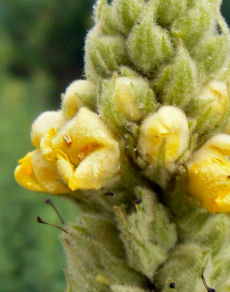 |
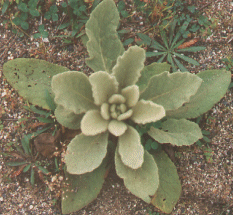
This Eurasian immigrant is a common biennial herb which produces a basal rosette of large, stalked, thick, fuzzy, oval leaves in the first year. These leaves often survive through the winter, under the snow. In the second year, mullein sends up a stoutly erect, sometimes branched, flower stalk, up to eight feet tall, which is also fuzzy, and has smaller, fuzzy, oval, unstalked, alternate leaves. The flower stalk makes this one of the plants I can still identify at 70 miles per hour, and often do, since roadsides are one of its favorite places. I also regularly find it in old fields, disturbed areas, vacant lots, wood edges, and in the middle of trails. It prefers alkaline soils with good drainage, likes full sun, and doesn't mind poor soil. |

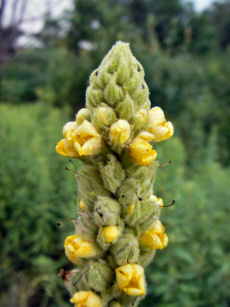
The yellow, unstalked, flowers appear in densely packed spikes, and bloom pretty much at random, a few at a time, from spring until fall. The flowers are small, an inch or less across, and cup-shaped, with five petals (fused at their bases), five stamens, and one pistil. The flowers are fragrant and taste sweet, the leaves are not fragrant and taste slightly bitter. However, the fresh or dried leaves do make a pleasant, soothing, mucilaginous tea (assuming you strain all the little hairs out). This tea can be consumed as a regular beverage, and it's good for you, providing vitamins B2, B5, B12, and D, choline, hesperidin, para amino benzoic acid, magnesium, and sulfur, but mullein tea is primarily valued as an effective treatment for coughs and lung disorders. Medicinally, it is expectorant, anti-inflammatory, antibiotic, astringent, and demulcent (which means soothing). It is especially soothing (and is a good tonic for) the lungs, mucous membranes, and glands. An alternative method, used in American Indian medicine and elsewhere, is to dry the leaves and smoke them, either alone or blended with other herbs (such as coltsfoot or jimsonweed), to treat asthma, bronchitis or other lung problems. This may actually work, but as I haven't tried it, I'll only vouch for the tea, which really does seem to help and may be somewhat sedative as well. |
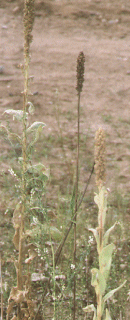

Mullein also contains coumarin and rotenone, a natural insecticide and fish poison, which is supposed to be non-toxic to mammals. It's important to use caution with medicinal or edible plants until you're familiar with their effects on your system. Start small, pay attention, and remember that all things are best in moderation. The leaves are a rubefacient, which means that if you rub them against your skin it will become red and irritated, which is something to remember when you're in the woods looking for toilet paper substitutes. It also means that when you've been handling it, your hands get a warm, fuzzy feeling. Some people have used this property for a natural sort of makeup, which is how mullein acquired the name 'Quaker rouge'. A tea made from the flowers reportedly has strongly soothing, sedative, properties. The flowers are used medicinally in the treatment of migraines and as a local antibiotic and bactericide. The flowers make a bright yellow dye, which can be used to dye hair or cloth. The addition of sulfuric acid will produce a color-fast green. If you then add an alkali, to raise the Ph, the dye becomes brown. Through the summer and early fall, the flowers fade, and the fruits appear. These fruits are hard, woody, capsules with five divisions, which open on one end when mature. After the fruits have matured, the plant dies, but the dry, brown, flower stalk persists through the winter, standing out against the snow. At this stage, if you soak the flower heads in tallow or something similar, it's supposed to make a good torch. The leaves, dried and rolled, have been used as lamp wicks. It's also helpful both as tinder for starting your campfire and as a quick burning fuel. If you're still not warm enough, the leaves also make pretty good insulation when placed inside shoes or clothing. From these uses, mullein is also called torches, candlewick plant, and beggar's blanket. |
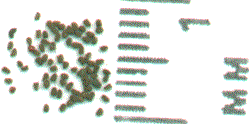
Mullein seeds, which are tiny, are reported to be toxic and have been used as a narcotic to stun fish. Animals won't eat mullein, because all those little hairs irritate their mucous membranes, but insects don't mind them. If you're trying to grow it, watch for weevils and slugs. Mullein also attracts a wide variety of pollinators, including bees, flies, and butterflies. Mullein is easily controlled by weeding, though I don't know why you'd want to except in wilderness and natural areas, where it's often considered an invasive species.
Selected References
|
|
| Home | About this site | Asides/Glossary | Store |
| Taxonomy Tree | Species list | Article list | |
|
Featured sponsors:
|
Mountain Rose Herbs Bulk herbs, teas, oils, & much more! |
Richter's Herbs Seeds & plants |
|
|
© 1999-2015 by Deb Schwartz. All rights reserved. Please send feedback to: deb@kingdomplantae.net Website by ki-yi.com
|
|||